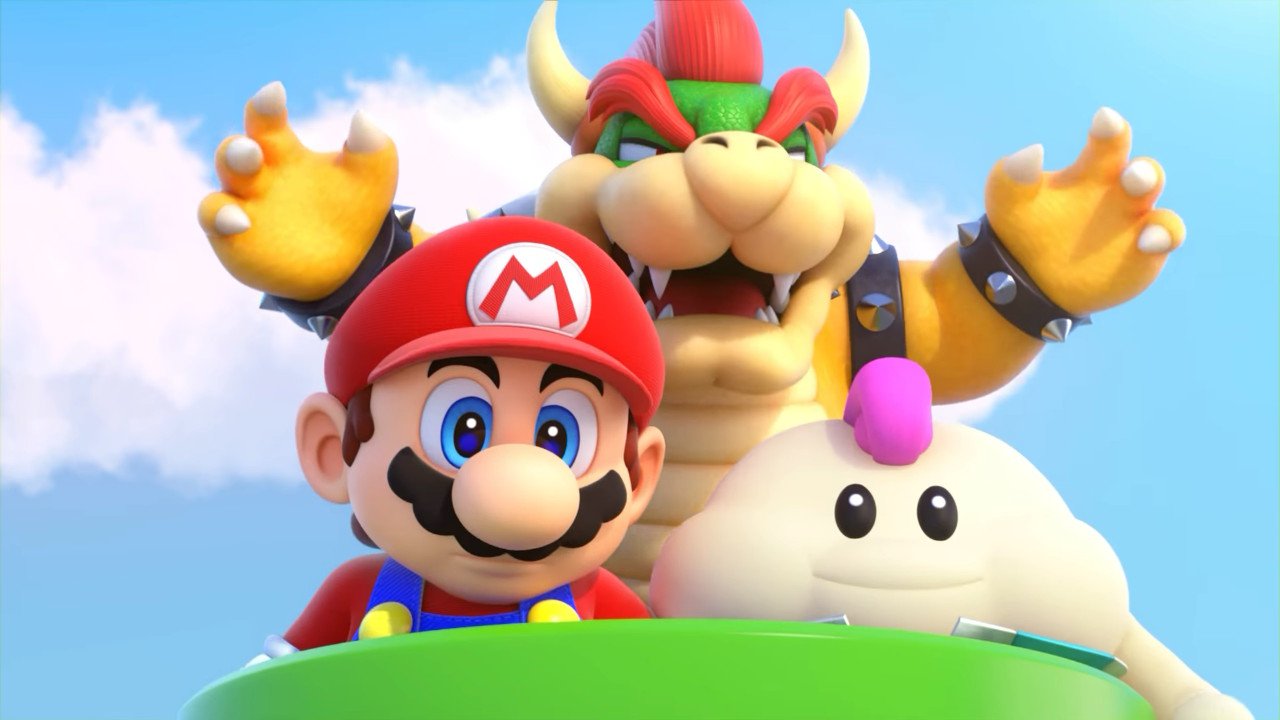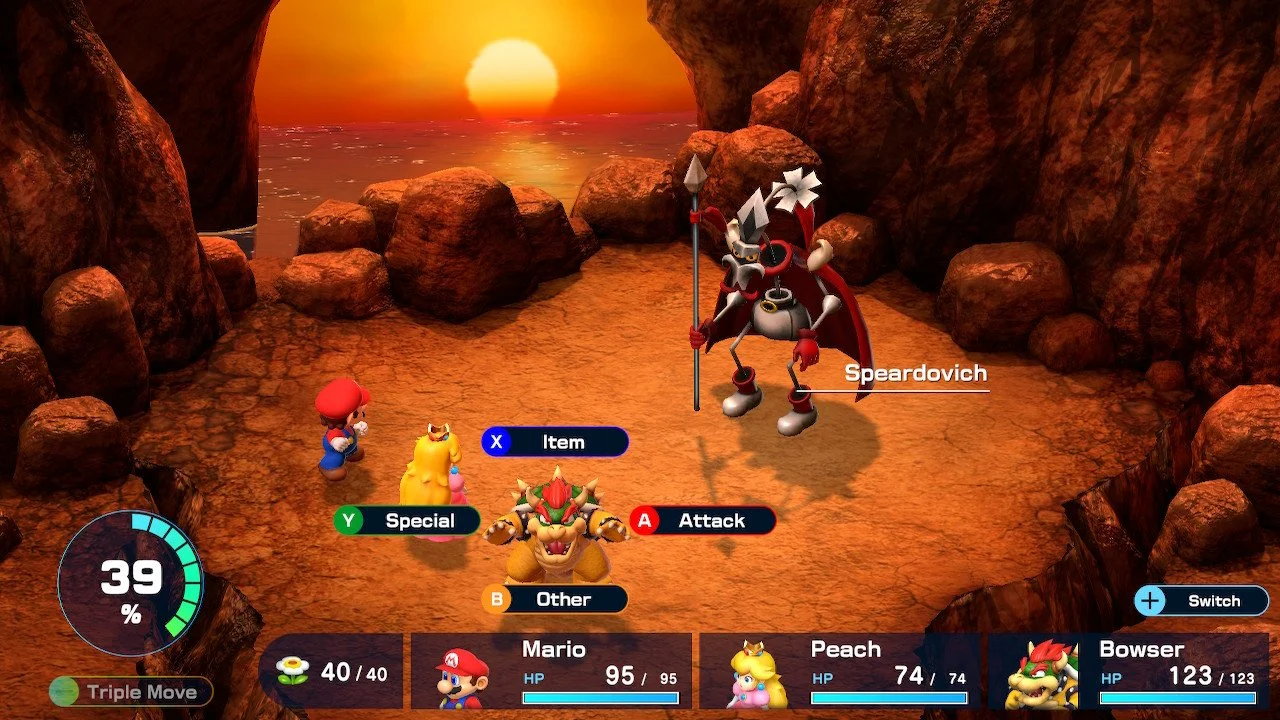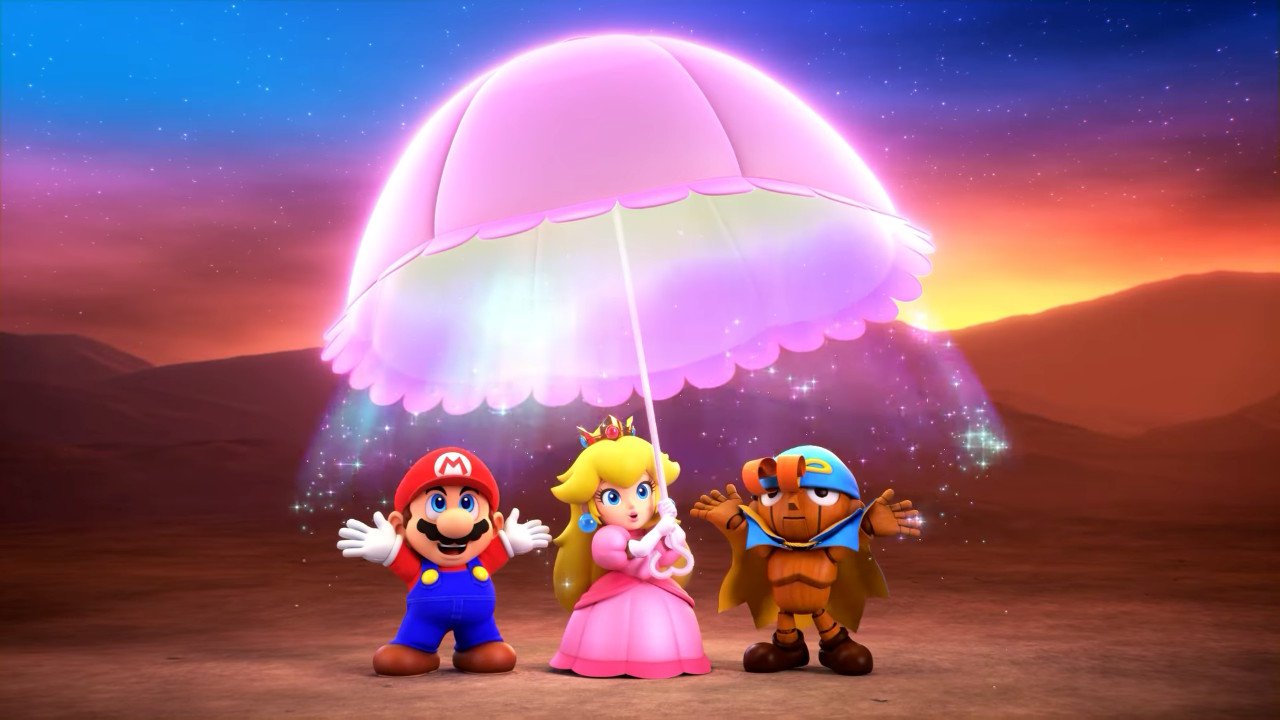Super Mario RPG Review - The Rebirth of An RPG Classic
/Long ago, way back in 1996, before the Mario RPG series split into the Paper Mario and Mario & Luigi subfranchises, there was a console called the SNES, and upon it, gamers were blessed with a most fruitful joint collaboration between Nintendo and then-Squaresoft, a game called Super Mario RPG: Legend of the Seven Stars. Being a Genesis kid, I never got to play the game upon its release, but I was acutely aware how this beloved adventure developed a hardcore fanbase and got a whole generation into JRPGs. While SMRPG has always sat near the top of my backlog for decades (literally on the first page of my Wii Menu), I sadly haven’t gotten around to it until now, so I’m pleased to be able to provide a first-time take on this rejiggered classic.
A Twist on the Classic Mario Setting
Our quest kicks off with Peach enjoying the flowers outside Mario’s house. Bowser swoops in to kidnap her, and Mario dashes off to the rescue, but their chandelier-top brawl is interrupted when a giant cartoon-eyed sword called Smithy drops out of the sky and bisects Bowser’s Castle. Seven multicolored stars are strewn about the landscape, and without spoiling too much, it’s fair to say that Mario will ally up with friends old and new in a race to make sure wishes can keep on coming true.
Right off the bat, I was happy to see that Super Mario RPG makes time for its character moments. The cloud-like Mallow, who was raised by frogs and can control the weather with his emotions, is shocked to discover that he was adopted. A mysterious but benevolent entity from beyond possesses a wooden puppet, taking on its name of Geno, and joins the party on what The Blues Brothers would call a ‘mission from God’. Bowser is able to let his pride down and induct you all into his cadre of minions, and once she’s been saved, Princess Peach rounds out the quintet by floating down from her tower, eager to help save the world as these delightful characters know it.
The story and characters were, to me, the highlights of the game. The writing is charming and soulful, and the folks you encounter are varied and endearing. Super Mario RPG also began a lot of the characterizations we now take for granted in the Mario universe. While Bowser was formerly a one-dimensional antagonist, here the big palooka is an arrogant and wounded giant, a sensitive softie at heart. And Peach proves to be more than cute - she’s capable and courageous, although mostly quiet. Geno and Mallow are beloved characters in their own right, and even throwaway side characters like Boshi and the pirate Jonathan Jones are memorable. While I found myself wishing for more one-on-one character moments and dialogues ala the Tales of series, this is a world worth saving. Each little tableau is sketched out just enough to keep you pleased, and no one location ever overstays its welcome.
You’ll travel between these typically small locales via the game’s isometric perspective. Mario will jump, swim, descend pipes, whirlpools, and sinkholes, and even ride minecarts and Yoshis at times. This is a pleasant, colorful world, and nearly every area has a unique flavor and set of enemies to tackle.
Turn-and-timing-based combat… with a triple threat!
In older JRPGs, it’s often the case that slow-paced combat is the weakest link. Super Mario RPG thankfully avoids that pitfall. Fights are simple and fast-paced, though they can sometimes drag a bit. Super Mario RPG’s timing- and input-variable attacks were another one of its novel elements upon release, and while the mechanic has been further explored in the Paper Mario and Mario & Luigi games, I was surprised to the extent that it was realized in this game. You’ll rotate the control stick for many status-causing attacks, time your button press to make Mario jump on someone’s head, or hold A until the right moment to unleash a couple of Geno’s devastating moves. You’ll be replenishing your FP (Flower Points) with store-bought or scavenged items, and leveling-up from random battles.
A major change is the ability to swap Party members while in a battle, which is incredible not just for healing, dealing damage, and filling up Mallow’s Journal with enemy info, but because doing so does not waste a turn. So you can swap to Peach and immediately heal the whole party, or swap to Geno and unleash a powerful blast. A couple of new additions include a Breezy difficulty option, not to mention a brand new combo system that rewards you for hitting your inputs at the right times.
Super Mario RPG introduces the Action Meter, which fills up from successful actions. Consecutive successful actions, both offensive and defensive, now form Combos that fill the Action Meter even quicker. Once full, Mario and two other party members will be able to perform a Triple Move - think 3-way Limit Breaks - with either offensive or defensive properties. These gorgeously rendered sequences are a great reward, and every combination of characters has a different effect, as well as associated animations. I love the flashy attacks, but there are defensive Triple Moves that can heal or fully block an incoming attack. Filling up the Action Meter and timing these Triple Moves is the key to success if you want to get through Classic mode without excessive grinding.
One of the Best SNES Graphical Facelifts
From what I gather, the fully-rendered cinematic sequences during a few parts of the story mode are new additions. These never felt out of place and added a lot of charm to the proceedings. In fact, I’ll go so far as to say the game’s presentation is one of its strongest suits, a major improvement over the awkwardly basic isometric look of the original game. The general look and feel of the characters really sells the original premise of chibi-fying the Mario cast and dropping them into a world that wouldn’t be out of place as a Saturday morning cartoon, or else a miniature diorama. The dancing animations on the level-up screen never failed to elicit a smile from me due to just how darned cute all the characters are dancing on stage together.
In addition to the gorgeous updated graphics and animations, the soundtrack has also been fully remastered. It is a treat for the ears. I’ve been familiar with the original soundtrack all of my adult life, listening to it once in a while, and while I probably will stick to the newer tracks, I’m happy that Nintendo kept the original SNES arrangements here - the old and new music can be swapped at any time.
But Is The Honeymoon Over Too Soon?
Super Mario RPG delivers one of the most joyous experiences I’ve had on my Switch, but the developers’ slavish devotion to recreating the original game’s decades-old design choices are both its greatest strengths and perhaps its greatest weakness, in the sense that the game is extremely straightforward and also quite short, with my playthrough clocking it at around twelve hours.
The original Super Mario RPG was gated by the storage and RAM limitations of the SNES, but this remaster had no such roadblocks. I’d normally not lament an extremely faithful adaptation of a classic, but this remake did add new content in the form of many game-breaking quality-of-life features. For instance, the ability to swap in party members at any time basically makes combat fairly braindead. Jumping to the World Map at any given time helpfully reduces the pain of backtracking from a labyrinth, but also blunts some of the challenge, effectively eliminating situations where you might be forced to play carefully or judiciously lest you run out of provisions.
One does get the sense that the developers could have added more to extend playtime, such as additional areas, side quests, story elements, character interactions, mini-games, or in-game challenges. As it stands, collecting all of the Frog Coins and endgame items will take some time, and the new Boss Rush mode is very welcome, but the experience is still over fairly quickly for a full-priced game. I would wait for a sale to take this plunge.
Hopefully A Sign of Better Things to Come
I loved every minute spent in the cozy, quirky world of Super Mario RPG, bopping to the remastered music, smiling at its humor and hijinks, timing battle actions, and enjoying my time spent with its memorable characters. While it’s a short and sweet experience, it never wears out its welcome, and you never know what silly challenge or minigame lies around the corner.
Mario, Peach, Bowser, Geno, and Mallow make an amazing team, and I am so happy to finally be able to say that I finished one of the SNES’ absolute bangers. I may have been left wanting a little more, but kudos to Nintendo for bringing back this updated classic, warming the hearts of fans worldwide, and bringing generations together to experience the charm and wonder of Super Mario RPG.
Verdict: 4/5 (Fantastic)
*We’ve recently changed our review score format from a 10-score rating to a 5-score rating. You can check out the definition of the new review score system on our About Us page.
PROS
Likeable cast and NPCs with a lot of personality
Beautifully updated graphics and soundtrack with new cut-scenes
Many quality-of-life features including additions to the battle system
CONS
The main story is over too quickly
Aside from the Boss Rush mode, the only replay value is for completionists/collectors
What I’ve Played
Finished the main story within 13 hours












Assassin’s Creed Shadows greatly blends the classic Assassin’s Creed stealth with the RPG elements of recent entries. Its dynamic world, seasonal changes, and improved stealth mechanics make exploration a joy, but Yasuke’s restrictive gameplay, overall story, and a half-baked notoriety system hold it back.